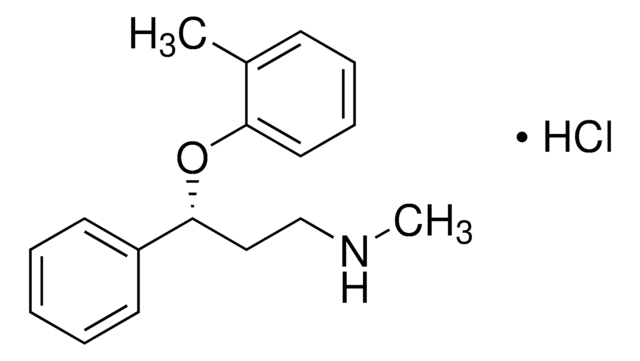T7947
(R)-Tomoxetine hydrochloride
solid
Synonym(s):
(R)-N-Methyl-γ-(2-methylphenoxy)benzenepropanamine hydrochloride, Atomoxetine hydrochloride
About This Item
Recommended Products
form
solid
originator
Eli Lilly
storage temp.
2-8°C
SMILES string
CNCC[C@@H](OC1=CC=CC=C1C)C2=CC=CC=C2.[H]Cl
InChI
1S/C17H21NO.ClH/c1-14-8-6-7-11-16(14)19-17(12-13-18-2)15-9-4-3-5-10-15;/h3-11,17-18H,12-13H2,1-2H3;1H/t17-;/m1./s1
InChI key
LUCXVPAZUDVVBT-UNTBIKODSA-N
Gene Information
human ... SLC6A2(6530)
Looking for similar products? Visit Product Comparison Guide
Application
- to study the role of L-threo-3,4-dihydroxyphenylserine (L-DOPS) in the pathogenesis of Alzheimer′s disease in mice
- to study its effects on set shifting in rats
- to study its effects on rat brain as a result of its long-term use
Biochem/physiol Actions
Features and Benefits
Storage Class Code
11 - Combustible Solids
WGK
WGK 3
Flash Point(F)
Not applicable
Flash Point(C)
Not applicable
Personal Protective Equipment
Certificates of Analysis (COA)
Search for Certificates of Analysis (COA) by entering the products Lot/Batch Number. Lot and Batch Numbers can be found on a product’s label following the words ‘Lot’ or ‘Batch’.
Already Own This Product?
Find documentation for the products that you have recently purchased in the Document Library.
Our team of scientists has experience in all areas of research including Life Science, Material Science, Chemical Synthesis, Chromatography, Analytical and many others.
Contact Technical Service






